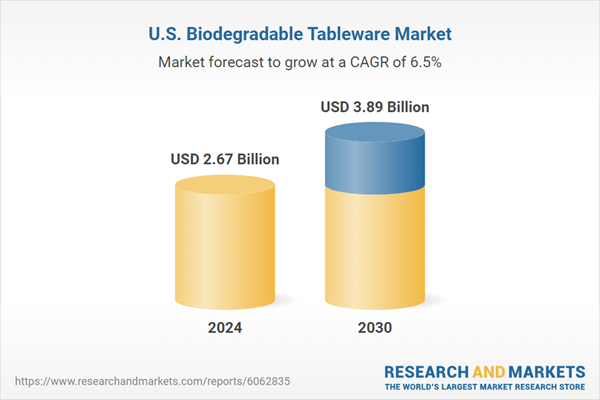Speak directly to the analyst to clarify any post sales queries you may have.
10% Free customizationThis report comes with 10% free customization, enabling you to add data that meets your specific business needs.
Businesses - particularly within the foodservice industry - are increasingly adopting compostable plates, cutlery, and packaging solutions to align with sustainability objectives. Core materials used in these products include plant-based fibers, cornstarch (PLA), and bagasse, which offer biodegradable and compostable options. Leading market players are prioritizing product innovation, cost optimization, and distribution network expansion to meet rising demand. Moreover, the growing popularity of sustainable dining solutions is supported by the proliferation of e-commerce and retail channels, enhancing product visibility and consumer adoption.
Key Market Drivers
Growing Environmental Awareness and Shifting Consumer Preferences
Environmental consciousness among U.S. consumers and businesses has emerged as a key catalyst for the biodegradable tableware market. As awareness of plastic pollution intensifies, consumers are actively seeking sustainable alternatives to conventional plastic or Styrofoam products. Millions of tons of plastic waste entering landfills and oceans each year have prompted individuals - especially millennials and Gen Z - to prioritize eco-friendly purchasing decisions.Biodegradable tableware made from natural materials such as bamboo, bagasse, cornstarch, and palm leaves is gaining traction. These products align with the values of environmentally conscious consumers who are committed to reducing their ecological footprint, driving increased demand for sustainable dining solutions.
Key Market Challenges
High Production and Retail Costs
One of the primary challenges facing the biodegradable tableware industry is the relatively high cost of production and retail pricing compared to conventional plastic alternatives. Manufacturing biodegradable products requires specialized raw materials such as bagasse, PLA, and other plant-based fibers, which are typically more expensive than petroleum-based plastics.Additionally, the processing of biodegradable materials involves complex production techniques that increase operational costs. Unlike traditional plastics - benefiting from decades of optimization and economies of scale - biodegradable materials are still in the developmental phase, and large-scale production remains cost-inefficient. This cost barrier can hinder broader adoption, particularly in price-sensitive segments of the market.
Key Market Trends
Adoption of Plant-Based and Innovative Materials
A prominent trend in the U.S. biodegradable tableware market is the increasing utilization of plant-based materials as sustainable alternatives to plastic. In response to rising environmental concerns and tightening regulations on single-use plastics, companies are investing in renewable, rapidly decomposing materials that offer both environmental and functional advantages.Bagasse, a byproduct of sugarcane processing, has emerged as a leading material due to its durability, heat resistance, and compostability - making it ideal for applications such as plates, bowls, and takeout containers. Bagasse naturally breaks down under composting conditions, contributing to waste reduction and landfill diversion.
Similarly, cornstarch-based bioplastics, particularly PLA (polylactic acid), are being widely adopted. PLA closely mimics the properties of traditional plastic but decomposes in industrial composting environments, offering a sustainable solution for disposable cups, straws, and utensils. These innovations are enabling manufacturers to meet environmental targets while offering high-performance alternatives to conventional tableware.
Key Market Players
- Lollicup USA Inc.
- Vegware Ltd.
- Dart Container Corporation
- Solia, Inc.
- Pactiv Evergreen Inc.
- Reynolds Consumer Products LLC
- VerTerra Dinnerware
- Green Paper Products
- Koch, Inc. (Dixie)
- Graphic Packaging International, LLC
Report Scope:
In this report, the United States Biodegradable Tableware Market has been segmented into the following categories, in addition to the industry trends which have also been detailed below:United States Biodegradable Tableware Market, By Product Type:
- Drinkware
- Plates
- Bowls
- Silverware
- Others
United States Biodegradable Tableware Market, By Material:
- Paper
- Bagasse
- Bamboo
- Palm Leaf
- Others
United States Biodegradable Tableware Market, By Distribution Channel:
- Offline
- Online
United States Biodegradable Tableware Market, By Region:
- South
- West
- Midwest
- Northeast
Competitive Landscape
Company Profiles: Detailed analysis of the major companies present in the United States Biodegradable Tableware Market.Available Customizations:
With the given market data, the publisher offers customizations according to a company's specific needs. The following customization options are available for the report.Company Information
- Detailed analysis and profiling of additional market players (up to five).
This product will be delivered within 1-3 business days.
Table of Contents
Companies Mentioned
- Lollicup USA Inc.
- Vegware Ltd.
- Dart Container Corporation
- Solia, Inc.
- Pactiv Evergreen Inc.
- Reynolds Consumer Products LLC
- VerTerra Dinnerware
- Green Paper Products
- Koch, Inc. (Dixie)
- Graphic Packaging International, LLC
Table Information
| Report Attribute | Details |
|---|---|
| No. of Pages | 81 |
| Published | April 2025 |
| Forecast Period | 2024 - 2030 |
| Estimated Market Value ( USD | $ 2.67 Billion |
| Forecasted Market Value ( USD | $ 3.89 Billion |
| Compound Annual Growth Rate | 6.5% |
| Regions Covered | United States |
| No. of Companies Mentioned | 10 |









